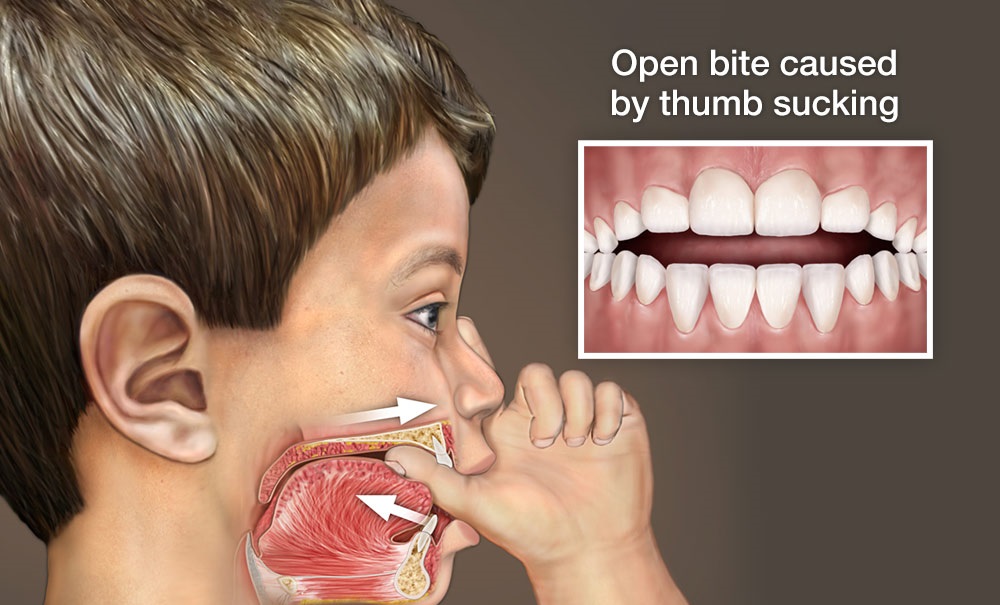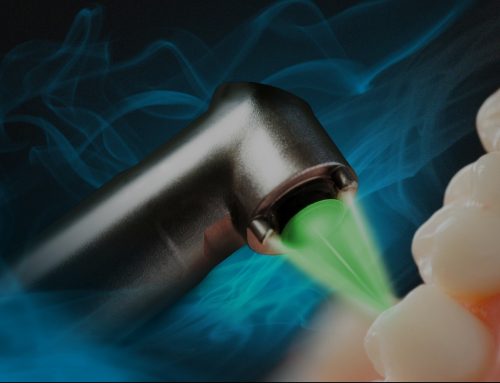The suckling reflex is natural for many infants and is often observed in the womb. This reflex is commonly satisfied through sucking on thumbs, fingers, and pacifiers, or when an infant is nursing. Suckling meets nutritional needs and provides comfort. Nutritive suckling (nursing or bottle feeding) plays a significant role in growth and development. Non-nutritive suckling (pacifier, thumb, finger) satisfies the desire to suckle, provides comfort, and offers a sense of security for newborns, infants, and toddlers.
Prolonged Use
Prolonged pacifier use, finger sucking, and thumb sucking can lead to significant problems with the front teeth, the shape of the upper jaw, and the eruption of permanent teeth.
- The upper front teeth may become flared outward; and the lower front teeth may become flared inward toward the tongue or outward toward the lips.
- The shape of the upper jaw may narrow, restricting the development of the nasal airway and even elongating the face. Airway alterations are linked to problems in brain development for children and creates other systemic problems that may surface later in life.
- The eruption of permanent teeth can be misdirected, resulting in a malposed or incorrect bite.
These oral complications are more likely to occur if a child continues to engage the suckling reflex past the age of two. Some of these oral complications require orthodontic treatment and in severe cases, complex surgeries to correct.
Good News & Recommendations
 The great news is that children often discontinue use of a pacifier on their own between the ages of 2 and 4 years. Some children, however, are rather reluctant to say good-by to their beloved pacifier or finger sucking habits. If a child is still using a pacifier beyond age 3, The American Academy of Pediatric Dentistry recommends intervention to discontinue pacifier use. Dr. Eric Hogan recommends starting this intervention before the age of two, because the suckling reflex is no longer necessary for nutrition. Trying to break this habit later can be more difficult and some growth alterations have already begun.
The great news is that children often discontinue use of a pacifier on their own between the ages of 2 and 4 years. Some children, however, are rather reluctant to say good-by to their beloved pacifier or finger sucking habits. If a child is still using a pacifier beyond age 3, The American Academy of Pediatric Dentistry recommends intervention to discontinue pacifier use. Dr. Eric Hogan recommends starting this intervention before the age of two, because the suckling reflex is no longer necessary for nutrition. Trying to break this habit later can be more difficult and some growth alterations have already begun.
Intervention Techniques
Here are some techniques that have helped others with this intervention process.
- Limit pacifier use to naptime and bedtime only, then cut back to bedtime only, then discontinue use completely.
- Reward and praise your child for the times when they do not use their pacifier or finger/thumb.
- Talk to your child about the effects of pacifier use, and that you want to help him/her to have a beautiful smile.
- Substitute the pacifier with an alternate security item like a soft silky blanket or plush stuffed animal.
- Cut a small hole in the tip of the pacifier.
- Make changes to bedtime routines, perhaps introducing story time.
An important reminder regarding pacifiers is to avoid dipping them in honey, syrup, or sugar water. Always offer your child a clean pacifier and discard when looking worn.
Which is better?
Which is better, a pacifier or sucking on a thumb or fingers? Both cause the same harm; however, the pacifier will be easier to take away. If you are concerned about the fact that your child has not given up their habit and needs some additional help, we would be happy to help with a dental exam and support.






